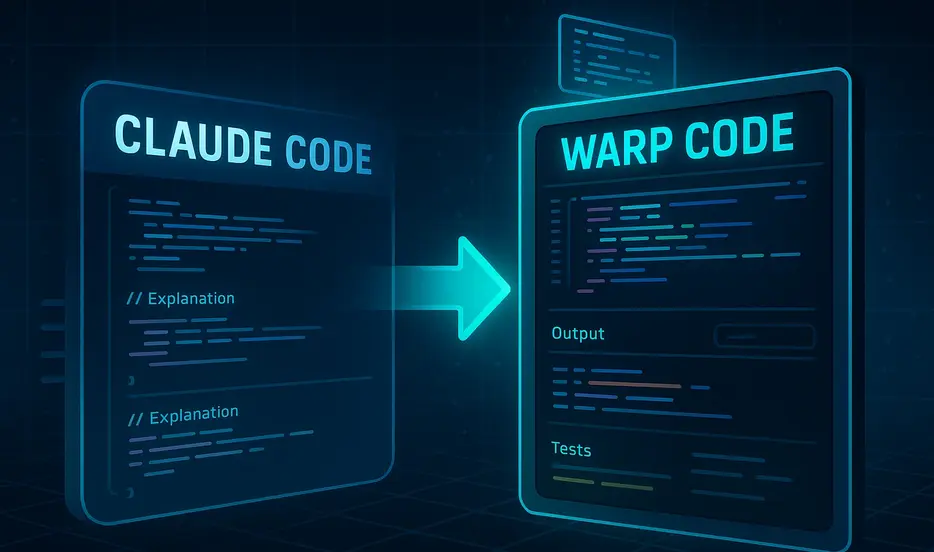Claude Code set the bar for AI-assisted coding with its IDE integration, context awareness, task lists, and diffs. For many developers, it became the standard not because it was perfect, but because there simply wasn’t anything else quite like it. However, the landscape is shifting dramatically with the arrival of Warp Code, which not only matches Claude Code point for point but actually goes further with its own unique personality and capabilities.
Warp’s latest release introduces coding features that are non-existent in Claude Code alone, including code review with line edit, code diffs, file tree navigation, and syntax highlighting. The company has already scored 71% on the SWE-bench (a primary benchmark for evaluating LLMs on coding tasks) and number one on Terminal Bench, 20% ahead of Claude Code. These results speak volumes about Warp’s positioning as a serious competitor in the AI coding space.
The Agentic Development Environment Philosophy
Warp’s approach centers on what they call an “Agentic Development Environment” where every task begins with a prompt. This philosophy represents a fundamental shift from traditional coding workflows, positioning AI as the primary interface for development rather than just an assistant tool.
The company has built everything into a single terminal environment, eliminating the context switching that developers hate when moving between terminals and IDEs. Instead of integrating AI into existing tools, Warp has created a unified environment where developers can work with AI agents, edit code, manage files, and execute commands all in one place.
This integrated approach means developers don’t need to leave the terminal for IDE functionality. Warp provides tabbed file editors with syntax highlighting and other essential IDE features without becoming a full-blown IDE, keeping the agent side of development at the forefront while maintaining the efficiency that terminal-based workflows provide.
Core Features That Match Industry Standards
Warp has successfully implemented the core features that have become standards in agentic coding tools. First among these is IDE compatibility, which Warp achieves through its integrated file editor. Developers can open files with Command+O, edit code with full syntax highlighting, and work alongside AI agents without leaving the terminal environment.
Context awareness represents another crucial capability. Warp indexes git-tracked codebases to help agents understand project structure and generate more accurate completions. The platform includes slash commands like /index to analyze codebases and /init to create warp.md files that document project architecture and setup commands, similar to Claude Code’s approach.
Task lists and diffs provide transparency into AI agent workflows. When developers prompt an agent, Warp creates a series of sequential tasks that it checks off as it works, showing exactly what the AI intends to do and allowing developers to verify alignment with their goals. As files are edited, added, or deleted, Warp displays diffs with syntax highlighting, enabling developers to review changes before accepting them.
Warp: Redefining Developer Productivity
Warp’s agentic development model isn’t just innovation—it’s a new standard. Context-aware terminals, live diffs, and transparent AI workflows are turning every developer into a one-person engineering team. The next wave of coding isn’t about writing more lines—it’s about collaborating with machines that understand your codebase. Developers who master these tools today will lead tomorrow’s AI-first engineering teams.
Explore AI Engineering Roles →Advanced Features That Surpass Claude Code
Where Warp truly differentiates itself is in features that go beyond what Claude Code offers. Active AI provides intelligent prompt suggestions based on terminal activity and suggests next commands using AI to predict what developers plan to type next. This creates a more dynamic and responsive coding experience.
The prompt library feature allows developers to save and reuse frequently used prompts, addressing a common pain point for developers who work with similar patterns across projects. This capability streamlines workflows and ensures consistency in AI interactions.
Model flexibility represents another significant advantage. While Claude Code restricts users to Claude models, Warp provides access to multiple models including GPT-5, Gemini, and Claude, giving developers choice based on their specific needs and preferences.
Voice dictation capabilities represent a forward-thinking approach to coding interfaces. As voice becomes an increasingly important input method, Warp’s voice features enable developers to speak their thoughts faster than they can type them, potentially revolutionizing how code is written and how developers interact with AI assistants.
The Terminal-First Advantage
Warp’s terminal-based approach provides several unique advantages over traditional IDE integrations. The platform maintains the efficiency and power of terminal workflows while adding sophisticated AI capabilities, creating an environment that many developers prefer for its speed and flexibility.
The integrated approach means developers can switch between terminal commands and AI prompts in the same session and tab, eliminating the friction of context switching. This creates a more seamless development experience where AI assistance feels natural and integrated rather than like a separate tool.
Warp’s careful feature selection ensures it doesn’t become bloated like full IDEs while still providing essential functionality. The platform focuses on what matters most for agentic development: efficient file editing, comprehensive diff visualization, and seamless AI integration, all within the familiar terminal environment.
The Future of AI-Assisted Development
Warp’s emergence signals a broader shift in how developers interact with AI tools. Rather than adapting AI to existing development environments, Warp has reimagined the development environment around AI capabilities, creating a more natural and efficient workflow.
The platform’s success suggests that the future of AI-assisted coding may not be about integrating AI into existing tools, but about creating new environments designed specifically for AI-human collaboration. This approach could lead to more intuitive and powerful development experiences that leverage AI’s capabilities more effectively.
As Warp continues to evolve, it’s likely to influence how other tools approach AI integration, potentially leading to a new generation of development environments that prioritize AI collaboration over traditional coding paradigms.




